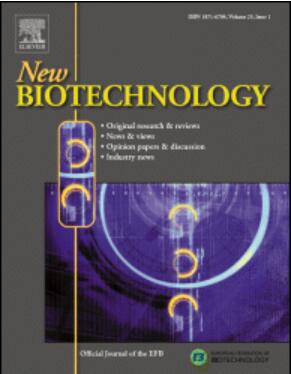Machine learning reveals novel compound for the improved production of chitooligosaccharides in Escherichia coli
IF 4.5
2区 生物学
Q1 BIOCHEMICAL RESEARCH METHODS
引用次数: 0
Abstract
In order to improve predictability of outcome and reduce costly rounds of trial-and-error, machine learning models have been of increasing importance in the field of synthetic biology. Besides applications in predicting genome annotation, process parameters and transcription initiation frequency, such models have also been of help for pathway optimization. The latter is a common strategy in metabolic engineering and improves the production of a desirable compound by optimizing enzyme expression levels of the production pathway. However, engineering steps might not lead to sufficient improvement, and bottlenecks may remain hidden among the hundreds of metabolic reactions occurring in a living cell, especially if the production pathway is highly interconnected with other parts of the cell’s metabolism. Here, we use the synthesis of chitooligosaccharides (COS) to show that the production from such complex pathways can be improved by using machine learning models and feature importance analysis to find new compounds with an impact on COS production. We screened Escherichia coli libraries of engineered transcription regulators with an expected broad range of metabolic diversity and trained several machine learning models to predict COS production titers. Subsequent feature analysis led to the finding of iron, whose addition we could show improved COS production in vivo up to two-fold. Additionally, the analysis revealed important clues for future engineering steps.
机器学习揭示了改善大肠杆菌中壳寡糖生产的新化合物。
为了提高结果的可预测性和减少昂贵的反复试验,机器学习模型在合成生物学领域变得越来越重要。除了预测基因组注释、过程参数和转录起始频率外,该模型还有助于途径优化。后者是代谢工程中的一种常见策略,通过优化生产途径的酶表达水平来提高所需化合物的生产。然而,工程步骤可能不会带来足够的改进,并且瓶颈可能仍然隐藏在活细胞中发生的数百种代谢反应中,特别是如果生产途径与细胞代谢的其他部分高度相互关联。本文以壳寡糖(COS)的合成为例,通过使用机器学习模型和特征重要性分析来发现影响COS生产的新化合物,可以改善这种复杂途径的生产。我们筛选了具有广泛代谢多样性的工程转录调控因子的大肠杆菌文库,并训练了几个机器学习模型来预测COS的生产滴度。随后的特征分析导致了铁的发现,我们可以发现铁的添加可以提高体内COS的产量高达2倍。此外,分析还为未来的工程步骤提供了重要线索。
本文章由计算机程序翻译,如有差异,请以英文原文为准。
求助全文
约1分钟内获得全文
求助全文
来源期刊

New biotechnology
生物-生化研究方法
CiteScore
11.40
自引率
1.90%
发文量
77
审稿时长
1 months
期刊介绍:
New Biotechnology is the official journal of the European Federation of Biotechnology (EFB) and is published bimonthly. It covers both the science of biotechnology and its surrounding political, business and financial milieu. The journal publishes peer-reviewed basic research papers, authoritative reviews, feature articles and opinions in all areas of biotechnology. It reflects the full diversity of current biotechnology science, particularly those advances in research and practice that open opportunities for exploitation of knowledge, commercially or otherwise, together with news, discussion and comment on broader issues of general interest and concern. The outlook is fully international.
The scope of the journal includes the research, industrial and commercial aspects of biotechnology, in areas such as: Healthcare and Pharmaceuticals; Food and Agriculture; Biofuels; Genetic Engineering and Molecular Biology; Genomics and Synthetic Biology; Nanotechnology; Environment and Biodiversity; Biocatalysis; Bioremediation; Process engineering.
 求助内容:
求助内容: 应助结果提醒方式:
应助结果提醒方式:


